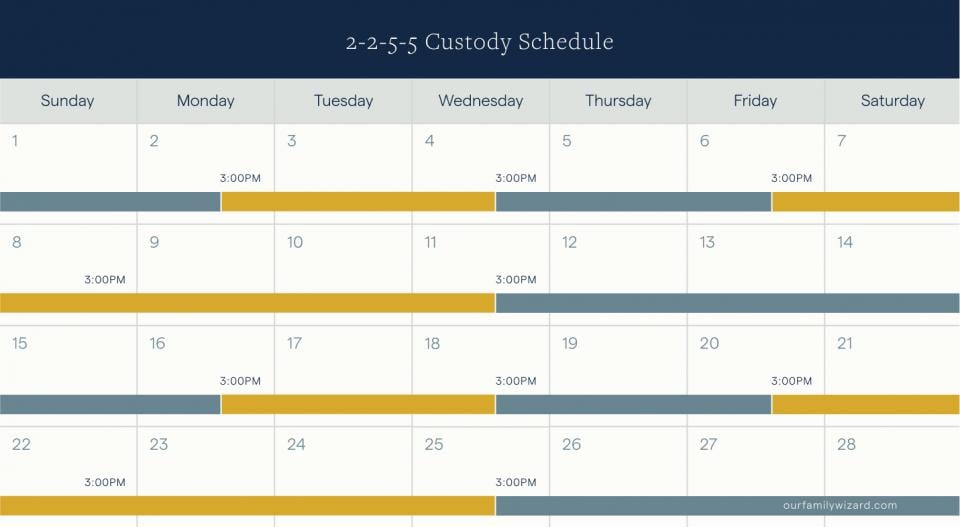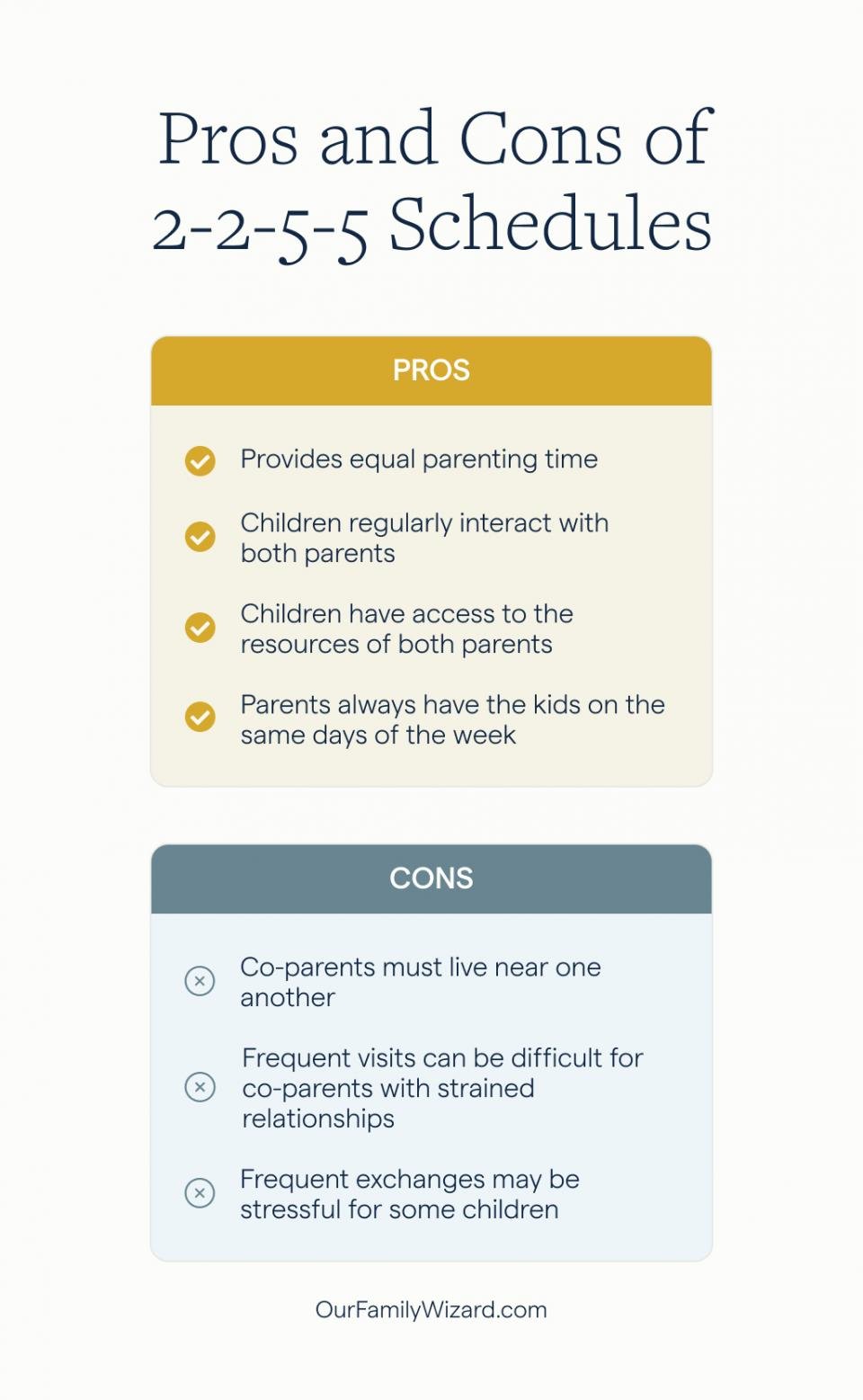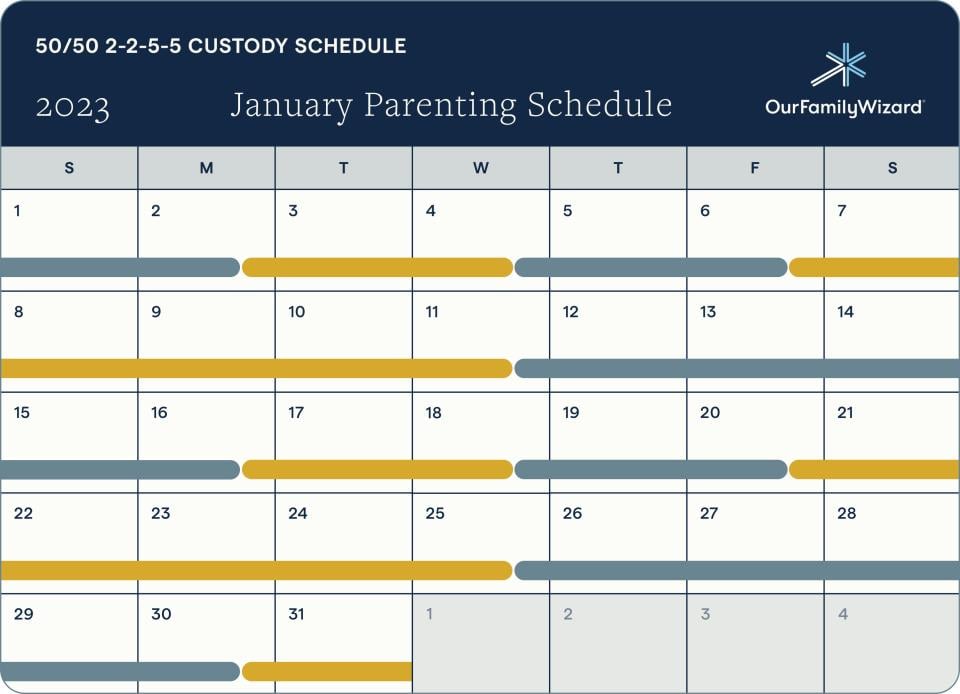
A co-parenting schedule can help you raise a family across different homes. Check out this comprehensive guide on the popular 2-2-5-5 custody schedule. Download a free parenting schedule template, learn from expert tips, and see if this rotation will fit your family.
Inside this article:
A 2-2-5-5 custody schedule is a shared parenting rotation that splits parenting time 50/50. Parents split time into two-day and five-day blocks. Many experts like this schedule because parents keep the same days every week, making it easier to remember.

You’ll often see the 2-5-5-2 schedule rotation referred to as a “custody schedule” or a “parenting schedule.”
Joint physical custody is a parenting arrangement where both parents have physical custody over their children. The children rotate their time living with each parent often on a set schedule. When deciding on a schedule, co-parents consider various aspects like work schedules, children’s schedules, children’s ages, and distance between housing to select a parenting plan that works for your unique situation. For those who want shared custody, a 50/50 split can be an attractive option.
50/50 custody schedules split parenting time equally. This schedule has grown in popularity, with many co-parenting feeling it is fair and gives kids adequate time with both parents. But a 50/50 custody schedule might not be right for all families. For one, splitting time down the middle introduces complexities that not all co-parents may be equipped to handle. Instead of one house being the dominant residence, parents with 50/50 custody must balance the logistical challenges of frequent exchanges with the emotional burden of long times apart.

Terri Breer, a family law attorney and mediator from California, says co-parents have a lot to think about even when they have agreed to share parenting time equally. “While they may want a schedule that allows for equal parenting time with each parent, co-parents need to consider additional schedules. For example, there might be a better way to break up the weekly parenting schedule, particularly if their work schedules or children’s needs suggest a different arrangement.”
The 2-2-5-5 parenting plan offers many benefits for parents who decide that a shared schedule will work best for their children. This rotation keeps the days of the week consistent between co-parents and minimizes time apart.
Key Takeaways:

In a 2-2-5-5 parenting plan, a child spends two nights with the first parent in the rotation and then two nights with the other parent. Then, the child spends five days with the first parent and five days with the other parent. In this schedule, each parent spends a long weekend with the kids.
Typically, co-parents start the 2-2-5-5 schedule on Monday. So, the first parent is with the kids for Monday and Tuesday. On Wednesday, they switch to their other parent’s home, where they stay for Wednesday and Thursday nights. On Friday, they’ll start a five-day stay back with the first parent.
Under this arrangement, one parent will always have Mondays and Tuesdays, and the other parent will have Wednesdays and Thursdays. Co-parents will switch the long weekend every other week. One long weekend will go from Friday to Wednesday, and the other will go from Wednesday to Monday. Another way to think about it is that whenever you have a five-day period, it will include your typical weekdays plus the long weekend.
Co-parents who want to minimize time apart from their children and maintain a consistent schedule can excel under the 2-2-5-5 plan. The schedule works best for co-parents who live near one another and have younger children.

Attorney James J. Sexton describes the 2-2-5-5 schedule this way: “A 2-2-5-5 provides the 50/50 split that so many people place emotional significance on, but without the problems inherent in an alternating week schedule. Rather than going a full week without seeing the children, in a 2-2-5-5 schedule you never go more than four days without seeing your children.”
Because each co-parent will have weekdays and weekends, both must be available to handle weekday pick-ups and enjoy kid-friendly weekend activities.
Here's a breakdown of the families that may excel with a 2-2-5-5 schedule. Note that some of these considerations may change as a child grows older.
The 2-2-5-5 strikes a difficult balance. It offers a very structured, easy-to-remember schedule while also being designed around minimal time apart – the kids see each parent at least once a week. Also, both parents get weekend time with the kids.
Here are the pros of a 2-2-5-5 schedule:
Sexton adds: “It’s easy to explain a 2-2-5-5 schedule to young children because it involves a lot of ‘always’ variables: ‘You will always be with Mommy on Monday, and it's easy to remember because "M" is the first word of Mommy and of Monday.’ That's easier for a child to understand than a statement like, ‘If I had you for the weekend last weekend there will be an overnight on the following Wednesday.’ It's easier for adults to understand, too.”

The 2-2-5-5 schedule will be difficult for parents who don’t want to communicate often. Also, some children will find it difficult to adjust to two primary homes. You can mitigate some of these challenges by ensuring both homes have everything the child needs.
The 2-2-5-5 schedule offers many benefits, but it’s not without challenges. Here’s a list of some potential issues with a 2-2-5-5 schedule:
But, as Breer points out, the 2-2-5-5 schedule can accommodate co-parents with tense relationships.
You can try a variation of the 2-2-5-5 schedule to fit your unique scheduling needs. These variations all start on different days but maintain the same two-week rotation. To better understand your options, check out different variations of the 2-2-5-5 schedule: 5-2-2-5, 5-5-2-2, and 2-5-5-2.
Example of 2-2-5-5 Custody Schedule

The 2-2-5-5 schedule is set up so that, if the rotation begins on Monday, both parents get alternating long weekends. But you can keep alternating weekends by starting some of the following variations on different days. Some co-parents can’t watch the kids over the weekends, and others may have very specific work schedules that make certain days off-limits.
The following variations may work better than 2-2-5-5 for families with unique scheduling needs.



Use this free 2-2-5-5 custody schedule template to see how your parenting schedule may look. Experiment with different exchange days and variations to determine which rotation will fit your family best.
Envisioning how a parenting schedule will work can be confusing. Instead of trying to map it out in your head, add your family’s obligations, schedules, and events onto a prebuilt and printable custody schedule. Immediately, you’ll notice issues, opportunities, and challenges. Then, you can tinker with different exchange days and decide if the schedule will help your family.

Before settling on a 2-2-5-5 schedule, consider going over some questions as a family to make sure the rotation will work well for everyone. For example, co-parents should honestly assess if their relationship can handle frequent exchanges. Also, ask your kids what they think.
Here's a list of questions that co-parents should discuss to determine if the 2-2-5-5 schedule will be the right fit:
Explore common alternatives to the 2-2-5-5 parenting schedule that still provide 50/50 custody. For example, co-parents who want fewer exchanges may consider alternating week schedules. Those that want to spend less time apart should check out the 2-2-3 schedule.
Here are three alternative schedules to the 2-2-5-5 that vary in the number of exchanges and the time kids spend apart from each parent.

OurFamilyWizard understands that to manage a family across two homes, a regular calendar won’t do. That’s why they designed a shared calendar and communication tools for co-parents. Managing a 2-2-5-5 schedule has never been easier.
Breer knows firsthand that communication between co-parents can be tricky. “I always recommend that parents use an app like OurFamilyWizard to assist with parenting communication whether they are perfect pals or angry foes in their co-parenting relationship.”
OurFamilyWizard’s shared Calendar app has all the features you need to keep your family in sync with the 2-2-5-5 schedule. Requesting extra weekend time or navigating the holidays will be less stressful with tools like schedule change requests and the holiday scheduler. The single shared parenting schedule minimizes conflict, improves communication, and alleviates stress.
A Note on Terminology
In general, the term “physical custody” refers to which parent a child lives with. Today, many experts use other terms to describe this arrangement, like “parenting schedule” or “parenting time arrangement.” These new terms better represent a relationship and the parent’s responsibilities for their children. But just a heads up: this article uses these older and newer terms interchangeably.

/sites/default/files/media/image/2023-09/headshot-elle-barr.jpg
Elle Barr is an experienced family law attorney with a deep commitment to serving children and families. She has experience representing clients in all family law matters, with an emphasis on serving as a court-appointed Guardian ad Litem (GAL) in New Jersey and Pennsylvania.
She also serves as the Judicial Education Coordinator for OurFamilyWizard. In this role, she educates judges, lawyers, and other family law professionals on the online tools that are used to reduce conflict and increase accountability in high-conflict co-parenting situations.